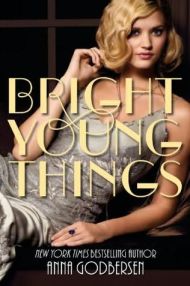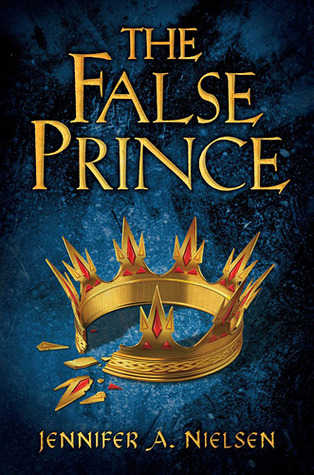 The Skinny: In a unique retelling of the Phantom of the Opera story, The Jumbee mixes the rich cultural heritage of the Caribbean with Shakespeare to create a romantic, suspenseful, and fantastical tale. Nevertheless, in thrusting so many characters and plot themes at the reader, this debut novel from Keyes could have used tighter editing. Whenever I review a book I try to think of which group of teens I might recommend it to; with The Jumbee I struggle to think of a person into whose hands I might place it. Romance readers might not be particularly satisfied with the ending; paranormal readers might not be satisfied with the vaguely and ill-defined supernatural elements plaguing this novel; and for those who do not read typically read either genre, I do not think this would be a good introduction.
The Skinny: In a unique retelling of the Phantom of the Opera story, The Jumbee mixes the rich cultural heritage of the Caribbean with Shakespeare to create a romantic, suspenseful, and fantastical tale. Nevertheless, in thrusting so many characters and plot themes at the reader, this debut novel from Keyes could have used tighter editing. Whenever I review a book I try to think of which group of teens I might recommend it to; with The Jumbee I struggle to think of a person into whose hands I might place it. Romance readers might not be particularly satisfied with the ending; paranormal readers might not be satisfied with the vaguely and ill-defined supernatural elements plaguing this novel; and for those who do not read typically read either genre, I do not think this would be a good introduction.
Setting: Cariba Island and Manchineel Cay, Current Day
From the time of her arrival to the (fictional?) island of Cariba, Esti Legard’s experience is punctuated by new sights, smells, music, and voices. While the setting clearly takes place in an island country with an articulated history of slavery, of racial and ethnic diversity, and with cultural and religious specificity, the island is not so detailed as to tie it to any one location. The nearby Manchineel Cay, a presumably treacherous island inhabited by dangerous supernatural beings, almost becomes a character in its own right; the warning signs posted along its shores and stories told by Cariba locals cast the island as a place that is not only home to evil beings but also as a force of nature that takes vengeance on those who encroach on her boundaries.
Characters:
Esti (Serene Terra) Legard, the main character of The Jumbee, is presented as a complex character who, throughout the novel, struggles with the death of her father and the legacy he left behind. Esti’s father, an internationally-known Shakespearean actor, died only months before she and her mother relocate from Oregon to Cariba and, as an actress herself, Esti both misses her father desperately for the guidance he once provided her and struggles to step out from behind his spotlight. While Esti appears a very strong character, she feels she must continually strive to maintain an appearance of control and she believably wavers between her trust in Alan, her questioning of his motives, and in her feelings toward her long-time friend/potential boyfriend Rafe. Nevertheless, Esti is not always well-defined; her motives are not always clear; and, ultimately, her character development wavers and is uneven.
Throughout most of the novel, Alan’s only presence comes through his voice and its effect on Esti, as well as events that transpire for which Alan is ultimately blamed. While Esti credits Alan with giving her the confidence to act again and for imbuing her performance with a power she felt lacking since the death of her father, the death, illness, expulsion and accidents that seem to happen within the theater (and its community) and under Alan’s control make him a character worthy of suspicion. Many believe that Alan is a Jumbee, an evil spirit that haunts the theater and the island, and question the relationship Esti seems to have forged with him. Esti vacillates between believing in Alan’s humanness and questioning his reality. In addition, Alan’s prior knowledge of Esti and her relationship with her father, as well as his emotional distancing and ultimate manipulation, make him down-right creepy.
Rafe Solomon and Esti were once childhood friends and the Solomon family maintains great influence on the island. Having not seen each other for several years, Esti and Rafe meet again and almost immediately reconnect as friends. Rafe, with his rakish good looks and bad-boy image, is well-known on the island as a player and many of the other women warn Esti against getting too close. At first Esti pushes Rafe away due to her feelings for Alan, but after an altercation with Alan, Esti and Rafe begin tentatively dating. Rafe, the once cad turned knight-in-shining armor, becomes more mature in a machismo-infused and very sudden way.
Voice:
Keyes’ narrative is limited third person, providing readers with Esti’s perspective. Readers can palpably sense Esti’s self-doubt, from her lack of confidence in her acting to her struggle in determining whether Alan is a real person, a jumbee, or a figment of her imagination. Based on the narrative voice, one might think readers could potentially learn more of Esti’s motivations or understand what calls her to take certain actions (or inactions as the case may be); I never felt that Esti was a very engaging or easy-to-follow character. She demonstrates incredible strength at times, but quickly quashes all self-assurance by allowing herself to be continually manipulated by Alan and his voice. Up to the very end, Esti acts possessed…but not in a fashion I think the author would have hoped for in this pseudo-supernatural romance. Blending Shakespearean dialogue with contemporary language and Caribbean dialect, The Jumbee gives readers a glimpse of realms with which they might not otherwise be familiar – including the Caribbean and the world of drama. Integrating lines from Shakespeare plays and sonnets also provides readers with an opportunity to analyze and understand his difficult language within a contemporary narrative.
Style:
Keyes’ combination of Shakespearean dialogue and poetry, contemporary language and Caribbean dialect is unique and the story, despite multiple layers, reads easily. Nevertheless, at times the Caribbean dialect seems forced and the addition of Caribbean traditions and beliefs often appears flimsy and undeveloped. Rather than reading as a Caribbean and modern take on Phantom of the Opera, The Jumbee can occasionally feel like the Phantom of the Opera with an “ethnic” veneer. The characters who could potentially give depth to the traditional beliefs of the Cariba Islanders, such as Lucia and Ma Harris, feel completely cursory and often appear in the narrative, deus ex machina style, to quickly explain why Esti should be fearful of Alan and, again, to explain away Alan’s unique existence.
Story:
More than anything, The Jumbee is a retelling of Phantom of the Opera with a twist of Romeo and Juliet. Esti moves to the island to begin again, to rediscover herself as an actress, and to escape the long shadow of her father, The Great Legard. Immediately there are some very strange circumstances that accompany her arrival: the sudden death of a classmate; increased competitiveness amongst her peers; and a voice that seems to speak to only her, advising Esti of how to break away from her father and to fulfill her own dreams. As the voice, Alan, begins to become more and more a part of her life, Esti withdraws from her mother, her new friends, and from a potential relationship with heartthrob Rafe. Although the physical aspect of Esti’s relationship with Alan is tenuous (Esti perceives his touch; Alan leaves Esti small tokens), she develops a bond with his voice that keeps her from becoming emotionally involved with other people and this relationship flirts with destructiveness throughout the novel. Even in the end, when Esti learns the truth of Alan, she is conflicted and relies on him to ultimately make her final choice. As the school’s preparations for and performances of the play Romeo and Juliet figure prominently within the book, one can also draw parallels between the two stories of star-crossed lovers.
I cannot claim to have a very close or sophisticated knowledge of Phantom of the Opera; I have never read Leroux’s book and saw only one stage production of the musical many years ago. But based on my reading of a synopsis of the original text on Wikipedia (do not cite this at home, kids), I’m going to step out on a limb and state that I think The Jumbee might be modeled too closely on the original for modern comfort, by which I mean that the very manipulative, stalker-ish feel to the relationship between Alan and Esti just might not read well for contemporary readers. I think there is a line between creating a creepy narrative (check) and making a story that is not very believable or consistently plotted but is also incredibly creepy in a way I’m not sure was intended (double check). That Alan might be an evil spirit of a long-dead vicious slave owner isn’t even the most disturbing part of this book. The relationship he forges with Esti is emotionally and, one might even argue, physically abusive. And while Esti sort of comes to terms with this and tries to help Alan, I never feel as though either character enacts change and that, if things were different, their relationship could go back to the way it had been with no discussion of how destructive and dangerous it had been or could be again.
Themes:
Throughout the novel, characters try to live with loss. Esti and her mother, Aurora, both respond to the death of their father and husband in very different ways. Esti’s grief is tinged with guilt, feeling as though she distanced herself from her father before his death and was never able to recover the close relationship they once had. She both misses his presence in her life tremendously and wants to step away from his influence, which leads to more guilt that she ever could or would try to find satisfaction in acting without him. Aurora is also grieving in ways that, as readers, we do not often see, but helps make obvious her emotional and physical absence from Esti’s life. They might live together, but Aurora suffers her loss most often alone and with wine. That Romeo and Juliet plays such an important role in the narrative also brings to the forefront a love that is tied up with loss and grief.
Esti also struggles with self-actualization, a theme which structures her character development. Esti is an actress who has always struggled to live up to the high expectations foisted upon her because of her father’s fame. She acts not only for herself, but for her father’s memory, which complicates her desire to both take advantage of the lessons her father instilled in her and to create a separate identity. While Esti believes Alan has helped her come to terms with her father’s death, as well as improve her acting skills, Esti ultimately begins to realize that no one can truly save her (although caring folks in her life are there to support her) and that change can only come from within.






 The Skinny
The Skinny



 The Skinny
The Skinny

 I finished reading Beautiful Darkness a couple of days ago, but I felt I needed some time and distance from it before I could fully evaluate the title. Although I thoroughly enjoyed the first book in this series, Beautiful Creatures, I did have some problems with it and Beautiful Darkness: most specifically that, although the novels take place in South Carolina and this state has a strong
I finished reading Beautiful Darkness a couple of days ago, but I felt I needed some time and distance from it before I could fully evaluate the title. Although I thoroughly enjoyed the first book in this series, Beautiful Creatures, I did have some problems with it and Beautiful Darkness: most specifically that, although the novels take place in South Carolina and this state has a strong  Shiver by Maggie Stiefvater
Shiver by Maggie Stiefvater Years of Dust by Albert Marrin
Years of Dust by Albert Marrin The Musician’s Daughter by Susanne Dunlap
The Musician’s Daughter by Susanne Dunlap Once Was Lost by Sara Zarr
Once Was Lost by Sara Zarr The Hate List by Jennifer Brown
The Hate List by Jennifer Brown
